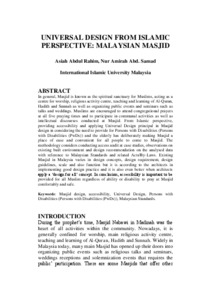Abdul Rahim, Asiah and Abd. Samad, Amirah
(2014)
Universal design from Islamic perspective: Malaysian masjid.
Journal of Architecture, Planning and Construction Management, 4 (2).
pp. 1-13.
ISSN 2231-9514
![[img]](http://irep.iium.edu.my/57276/8.hassmallThumbnailVersion/03%20Prof%20Asiah.pdf)  Preview |
|
PDF (Universal Design from Islamic Perspective: Malaysian Masjid)
- Published Version
Download (689kB)
| Preview
|
Abstract
In general, Masjid is known as the spiritual sanctuary for Muslims, acting as a centre for worship, religious activity centre, teaching and learning of Al-Quran, Hadith and Sunnah as well as organizing public events and seminars such as talks and weddings. Muslims are encouraged to attend congregational prayers at all five praying times and to participate in communal activities as well as intellectual discourses conducted at Masjid. From Islamic perspective, providing accessibility and applying Universal Design principal in Masjid design in considering the need to provide for Persons with Disabilities (Persons with Disabilities (PwDs)) and the elderly has deliberately making Masjid a place of ease and convenient for all people to come to Masjid. The methodology considers conducting access audit at case studies, observations on existing built environment and design recommendation on the analysed data with reference to Malaysian Standards and related Acts/By-Laws. Existing Masjid in Malaysia varies in design concepts, design requirement, design guidelines, scale and also function but it is according to the architects in implementing good design practice and it is also even better when architects apply a ‘design for all’ concept. In conclusion, accessibility is important to be provided for all Muslim regardless of ability or disability to pray at Masjid comfortably and safe.
Actions (login required)
 |
View Item |


 Download Statistics
Download Statistics Download Statistics
Download Statistics